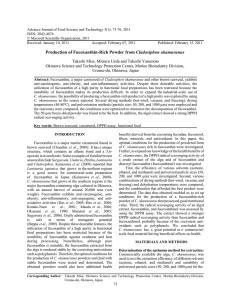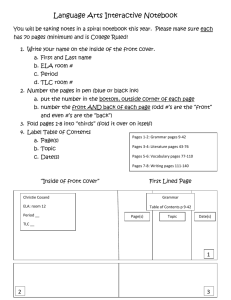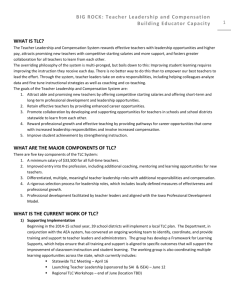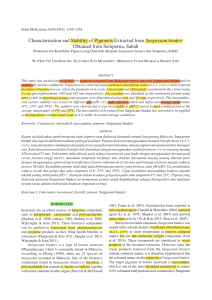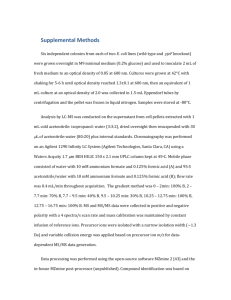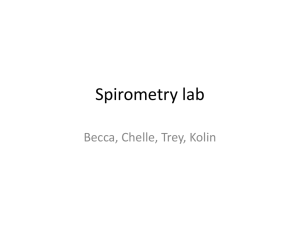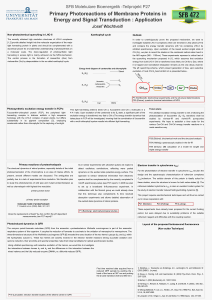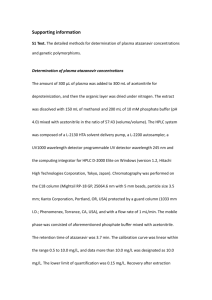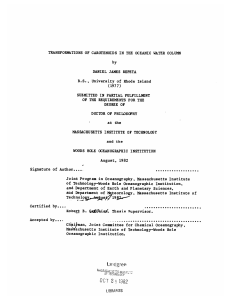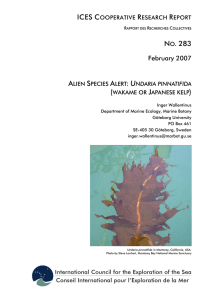supplementary material
advertisement
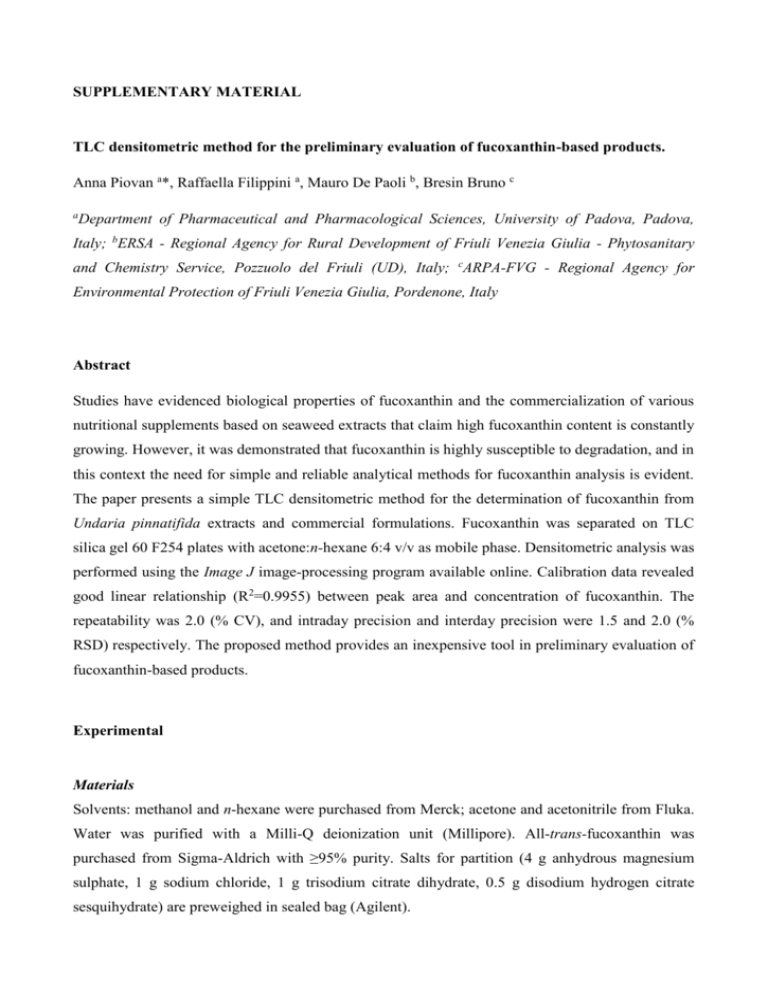
SUPPLEMENTARY MATERIAL TLC densitometric method for the preliminary evaluation of fucoxanthin-based products. Anna Piovan a*, Raffaella Filippini a, Mauro De Paoli b, Bresin Bruno c a Department of Pharmaceutical and Pharmacological Sciences, University of Padova, Padova, Italy; bERSA - Regional Agency for Rural Development of Friuli Venezia Giulia - Phytosanitary and Chemistry Service, Pozzuolo del Friuli (UD), Italy; cARPA-FVG - Regional Agency for Environmental Protection of Friuli Venezia Giulia, Pordenone, Italy Abstract Studies have evidenced biological properties of fucoxanthin and the commercialization of various nutritional supplements based on seaweed extracts that claim high fucoxanthin content is constantly growing. However, it was demonstrated that fucoxanthin is highly susceptible to degradation, and in this context the need for simple and reliable analytical methods for fucoxanthin analysis is evident. The paper presents a simple TLC densitometric method for the determination of fucoxanthin from Undaria pinnatifida extracts and commercial formulations. Fucoxanthin was separated on TLC silica gel 60 F254 plates with acetone:n-hexane 6:4 v/v as mobile phase. Densitometric analysis was performed using the Image J image-processing program available online. Calibration data revealed good linear relationship (R2=0.9955) between peak area and concentration of fucoxanthin. The repeatability was 2.0 (% CV), and intraday precision and interday precision were 1.5 and 2.0 (% RSD) respectively. The proposed method provides an inexpensive tool in preliminary evaluation of fucoxanthin-based products. Experimental Materials Solvents: methanol and n-hexane were purchased from Merck; acetone and acetonitrile from Fluka. Water was purified with a Milli-Q deionization unit (Millipore). All-trans-fucoxanthin was purchased from Sigma-Aldrich with ≥95% purity. Salts for partition (4 g anhydrous magnesium sulphate, 1 g sodium chloride, 1 g trisodium citrate dihydrate, 0.5 g disodium hydrogen citrate sesquihydrate) are preweighed in sealed bag (Agilent). Undaria pinnatifida samples were collected (Isola dell’Unione, Chioggia, Venice, Italy) in May 2011 and authenticated by Dr M. Marzocchi (Department of Biology, University of Padova). A voucher specimen (No. UP1511) was deposited at the Department of Pharmaceutical Sciences, University of Padova. Commercial products: U. pinnatifida dry extract (fucoxanthin 5.86%), liquid and tablets containing U. pinnatifida dry extract (fucoxanthin 15 mg/vial and 5 mg/tablet). Standard stock solution A stock solution of fucoxanthin was prepared in acetonitrile at a concentration of 1 mg mL-1 and stored at -20°C in amber-colored vials to protect fucoxanthin from light. The working solutions were accurately diluted with acetonitrile just prior to use. Sample preparation Collected seaweed samples were washed with water, lyophilized and stored at -20°C. Samples (25 g) were reconstituted with milliQ water (100 g) and homogenized with Ultra Turrax to obtain a paste. Dry extract (0.4 g) was added to 20 mL of water; tablets (4 g) were homogenized with Ultra Turrax in 16 mL of water; liquid preparation was used as is. Extractions have been performed on 10 g of samples with 10 mL of acetonitrile. The acetonitrile extracts were obtained by salt-induced phase-separation (fucoxanthin recovery 93%) (Piovan et al. 2013). The acetonitrile extracts were used for the analyses. TLC analysis TLC analysis was performed on TLC plate 20×10 cm silicagel 60 F254 layer 0.25 mm glass backed. Before use plates were conditioned by complete elution with methanol, dried at 120°C for 15 min and equilibrated at room temperature for 20 min under hood. Sample solutions (40 μL) were applied as 8 mm bands by means of a Camag (Muttenz, Switzerland) Linomat III semi-automatic sample applicator equipped with a Camag 100 μL syringe. The plates were developed with 10 mL of mobile phase (acetone:n-hexane 6:4 v/v) (Hertberg et al. 1988) in a Camag twin trough chamber previously saturated with mobile phase for 20 min (filter paper); the development distance was 70 mm. The plate images were acquired with an Epson V200 Photo flatbed scanner and elaborated using the Image J image-processing program (available online and developed by the National Institutes of Health, USA). For linearity evaluation, aliquots of standard stock solution were drawn and diluted to obtain the working solutions, which were then applied to TLC plates to prepare eleven point (0.15-5 µg) linear calibration curves. The peak areas and the corresponding amounts were subjected to linear least square analyses. The method was validated for repeatability and intermediate precision (intra and interday precision). Repeatability was affirmed by multiple measurements (n=4) of standard solution (0.25 µg) and U. pinnatifida acetonitrile extract (8 mg) under same analytical and laboratory conditions and was expressed as percent coefficient of variation (% CV). Intermediate precision was studied by analyzing aliquots of standard solutions and U. pinnatifida extract on the same day (intraday precision) and on different days (interday precision). The results were expressed as percent relative standard deviation (% RSD) between different days. HPLC MS/MS analysis HPLC analysis was performed on an Agilent 1200 LC device (Agilent Technologies, Waldbronn, Germany) with binary pump, degasser and autosampler. The separation was achieved with a reversed-phase analytical column, Synergi Fusion column (150x3 mm i.d., 4 µm; Phenomenex, Torrance, CA, USA) using an isocratic elution; the column oven temperature was 30°C, and the injection volume was 20 µL. The mobile phase was composed of methanol:water, 90:10; the flow rate was 0.5 mL min-1. The APCI-MS analysis was performed using a LTQ (Thermo Finnigan, San Josè, CA, USA), operating in the positive ion mode. Sheath gas and auxiliary gas flow rates were 20 and 5 (arbitrary units) respectively, source voltage 3 kV, source current 5 µA and entrance capillary temperature 280°C. Collision-induced dissociation spectra were obtained applying a supplementary RF voltage, 6 V, to the end caps of the ion trap. The data were recorded and processed using Xcalibur Workstation (monitored ions: [M+H]+ 659, [M+H-H2O]+ 641, [M+HH2O-CH3COOH]+ 581). References Hertzberg, S., Partali, V., & Liaaen-Jensen, S. (1988). Animal carotenoids. 32. Carotenoids of Mytilus edulis (edible mussel). Acta Chemica Scandinavica. Series B. Organic Chemistry and Biochemistry, 42, 495-503. Piovan, A., Seraglia, R., Bresin, B., Caniato, R., & Filippini, R. (2013). Fucoxanthin from Undaria pinnatifida: photostability and coextractive effects. Molecules, 18, 6298-6310. Figure S1. Colour image under visible light of TLC plate silica gel 60 F254 with fucoxanthin standard (1-5 µg) and U. pinnatifida extract replicates (UP1-UP3) developed with acetone:n-hexane 6:4. Figure S2. Densitogram obtained with ImageJ software from plate image with integration of fucoxanthin peak. Figure S3. Fucoxanthin regression curve from LC-MS data of ion 641. Fucoxanthin concentrations ranged from 0.05 to 2.0 µg mL-1. Figure S4. Chromatogram of fucoxanthin standard at m/z 641 and relative spectrum. Figure S5. Chromatogram at m/z 641 of Undaria pinnatifida extract and relative spectrum; peak at 6.89 min has the same spectrum of fucoxanthin standard and is attributed to cis-isomers of fucoxanthin. Figure S6. Colour image under visible light of TLC plate silica gel 60 F254 with fucoxanthin standard (0.15-0.5 µg) and U. pinnatifida commercial dry extract (DE), tablets (A) and liquid (B) formulations developed with acetone:n-hexane 6:4.

